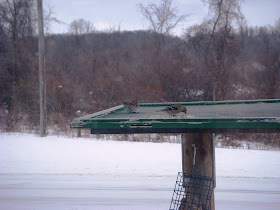Scott: "Wasn't it
two years ago at Notre Dame that we saw a Merlin?"
Lindsay: "Yeah... I was at work, so I didn't get to see it."
Scott: "It was just as we pulled into the parking lot."
(Pulling into parking lot...)
Scott: "The Merlin was on that small tree."
(Passing the small tree...)
Scott: "Look! There's the Merlin!"

When Lindsay and I headed to University of Notre Dame this morning to join
South Bend-Elkhart Audubon Society on a field trip to look at waterfowl, seeing a Merlin (
Falco columbarius) never even crossed my mind. I was pretty sure that the one we saw in the parking lot off of Dorr Road (Scott: "You make a better Dorr than a Road!) two years ago was a freak occurrence. I guess not. Now, I wonder if this bird winters here every year. What a great first bird for a field trip!
In the photograph below, note two of the identifying characteristics on this otherwise somewhat nondescript raptor: the weak mustache and the white eyebrow.

But we weren't done. Brian Miller and I later joked that had the weather been like it was the past couple of days, we would probably have been the only two to show up for the field trip, and we probably would have left after seeing the Merlin. The mid-30 degree Farenheit temperatures on this sunny February day were perfect for a two-hour walk around St. Joseph's Lake.

Mallards (
Anas platyrhynchos, in the background of the photograph above) were by far the most abundant species on the lake, but one of our highlight birds was the migrant in the foreground above, Redhead (
Aythya americana). Interestingly, female Redheads lay their eggs in the nests of other Redheads or other ducks, supposedly often in the nests of the somewhat similar looking and related Canvasbacks (
Aythya valisineria).

The number of Common Mergansers (
Mergus merganser, in the photograph above) on the lake was quite impressive. I counted 81, but I am sure that I missed some. We often see Common Mergansers on St. Joseph's Lake in the winter, but not in these numbers. When Brian, Lindsay, and I did the Indiana Mid-winter Waterfowl Count at Notre Dame earlier this year, we didn't see any Common Mergansers.

One of the most handsome ducks, in my opinion, is the Hooded Merganser (
Lophodytes cucullatus, above). It must be the afro, as Lindsay calls it. This species is somewhat of a staple at St. Joseph's Lake.

The most common gull that we saw on the lake today was Herring Gull (
Larus argentatus, or
L. smithsonianus, if you choose to split the European Herring Gull from the American Herring Gull). The immature Herring Gull in the photograph above has the characteristic pink legs and thick bill. Adult Herring Gulls have a white body with a gray back and wings, black and white wingtips, and a yellow bill with a red spot on the lower mandible.

We only saw one Mute Swan (
Cygnus olor, above) on the lake. Visiting St. Joseph's Lake, you can usually count on seeing at least one of this attractive Eurasian species.
Our complete list of species observed during the field trip follows:
Canada Goose
Mute Swan
Domestic Duck
American Black Duck
Mallard
Redhead
Lesser Scaup
Common Goldeneye
Hooded Merganser
Common Merganser
Pied-billed Grebe
Horned Grebe
Great Blue Heron
Cooper's Hawk
Merlin
American Coot
Ring-billed Gull
Herring Gull
Belted Kingfisher
Red-bellied Woodpecker
Downy Woodpecker
Northern Flicker
Black-capped Chickadee
Tufted Titmouse
White-breasted Nuthatch
American Robin
Cedar Waxwing
Song Sparrow
Dark-eyed Junco
Northern Cardinal
House Finch






















